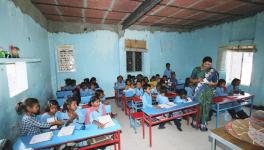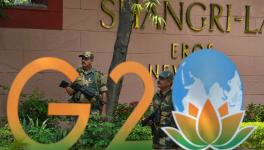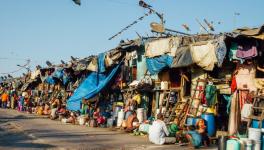Data: Inequality Breeds Poverty, High Growth Rates Cannot Fix It
The prolonged lockdowns and extended economic shutdowns during the Covid-19 pandemic hurt every section of India’s population, but the poor shouldered its heaviest burden. The reason is not just that productive activities ceased for months, but they exacerbated a pre-existing trend of the last three decades: burgeoning inequality.
The latest Multidimensional Poverty Report of the UNDP has found that India accounts for 227 million of the world’s 1.39 billion poor. The report finds that five out of six multidimensionally poor belong to the Scheduled Castes, Scheduled Tribes and Other Backward Castes (SC, ST and OBC). Therefore, India is home to the highest number of poor who battle hunger and malnutrition, stand deprived of education, and confront discrimination along caste lines. Earlier, a March 2021 report of the Pew Research Center revealed that as the impact of the pandemic intensified, an additional 75 million Indians were pushed into poverty, and the middle class shrank by 32 million.
Although the mainstream discussion in India is now about GDP growth rates, the critical question is whether it will help the poor recover economically. Due to inequality—India contributed 60% of the rise in poverty during the pandemic, yet has the third-largest number of billionaires—the GDP growth rate has a weak connection to reduction in incidence of poverty.
Inequality in the Indian economy is at a record high. The share of the top 1% in national wealth is now close to half the total estimated wealth in the country. Meanwhile, the bottom 20% subsist on around 3% of the national wealth. Even when we consider 50% of the lowest-income population, it only has a 15% share in the national income, while the share of income of the top 1% is over 20%. Besides, the top 1% almost tripled their share in the national wealth and nearly doubled their share in national income in the last thirty years. India is now close to joining the world’s most unequal economies.
In recent decades, land redistribution in rural areas has come to a near standstill. Land ceiling laws are increasingly ignored or eroded. Instead, governments focus on securing land for industry and urbanization. Small farmers are under increasing stress, especially from debt. During the decade beginning 2001, a hundred farmers became landless every hour.
In the guise of codifying labour laws, substantial gains achieved earlier have been eroded. Social security for unorganized sector workers has witnessed more promises than gains. Pension schemes for the elderly and widows are stagnant, or their budget allocations were cut, except for short-term relief during the pandemic. The dilution of already limited benefits does not augur well. Most workers in the organized sector are less secure as contractual work is the norm.
Taxation policies have also aggravated inequality, as the share of indirect taxes has increased while the corporate tax rates have decreased in recent years. The fast-rising share of the top 1% in wealth and income signals the government’s reluctance to garner resources for economic or social uplift.
An Oxfam report on ‘The Inequality Virus” and its India supplement released in January said it would take an unskilled worker 10,000 years to make what billionaire Mukesh Ambani made in an hour during the pandemic. Every second, the billionaire makes what a worker would take three years to earn. The report notes that wealth exponentially grew for many leading billionaires since March 2020, when India announced the world’s biggest lockdown. This report says 1,70,000 people lost their jobs every hour for several days in April 2020.
The India Supplement shows that the 400 million informal workers at risk of falling into poverty during the pandemic could have stayed above the poverty line for at least five months with a fraction of what the wealthiest billionaires made. Indian billionaires were 35% wealthier after the lockdown according to the Oxfam report, which means they are 90% richer since 2009 and corner a tidy US$ 422.9 billion. The wealth of the top 11 Indian billionaires during the pandemic could sustain the health ministry budget for ten years.
The mass exodus triggered by the sudden lockdown and the inhuman conditions of informal workers turned a health emergency into a humanitarian crisis in India. During the lockdown, many informal-sector workers died of starvation, suicide, exhaustion, accidents, police brutality, and denial of timely medical care. The National Human Rights Commission recorded over 2,582 cases of human rights violations as early as April 2020—just a month into the lockdown.
There will be longer-term adverse effects for India’s poor, and inequalities are bound to grow as things stand. Education, the favoured road to upward mobility, was seriously hurt during the pandemic, and inequality in access to primary education increased as never before. The Observer Research Foundation said in a study that 250 million children were hurt when schools were closed. The prolonged disruption of schooling risks doubling the rate of school drop-outs. Most of the drop-outs belong to low-income families. Only 4% of rural households owned a computer. And fewer than 15% of rural households had an internet connection, the National Sample Survey Office found in its study titled “Household Social Consumption: Education”, published in July this year.
The chances that girls would go to school fell, as multidimensional poverty studies recently found. Educated women and girls are a significant factor for families to emerge from poverty, but women have faced deeper exclusions in recent times. Around 17 million lost their job in April 2020, and the female unemployment rate rose 15% from the already-high pre-lockdown of 18%.
Inequalities worsened in India over the last three decades of neoliberalism, and the pandemic aggravated the situation. Merely hiking up the growth rate will not work now, as specific and widespread efforts alone will help reduce inequality, which is at the core of India’s growing poverty.
The writer is a journalist and author involved with several social movements. The views are personal.
Get the latest reports & analysis with people's perspective on Protests, movements & deep analytical videos, discussions of the current affairs in your Telegram app. Subscribe to NewsClick's Telegram channel & get Real-Time updates on stories, as they get published on our website.
























